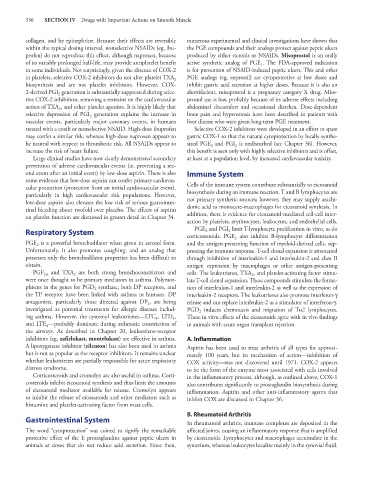Page 350 - Basic _ Clinical Pharmacology ( PDFDrive )
P. 350
336 SECTION IV Drugs with Important Actions on Smooth Muscle
collagen, and by epinephrine. Because their effects are reversible numerous experimental and clinical investigations have shown that
within the typical dosing interval, nonselective NSAIDs (eg, ibu- the PGE compounds and their analogs protect against peptic ulcers
profen) do not reproduce this effect, although naproxen, because produced by either steroids or NSAIDs. Misoprostol is an orally
of its variably prolonged half-life, may provide antiplatelet benefit active synthetic analog of PGE . The FDA-approved indication
1
in some individuals. Not surprisingly, given the absence of COX-2 is for prevention of NSAID-induced peptic ulcers. This and other
in platelets, selective COX-2 inhibitors do not alter platelet TXA PGE analogs (eg, enprostil) are cytoprotective at low doses and
2
biosynthesis and are not platelet inhibitors. However, COX- inhibit gastric acid secretion at higher doses. Because it is also an
2-derived PGI generation is substantially suppressed during selec- abortifacient, misoprostol is a pregnancy category X drug. Miso-
2
tive COX-2 inhibition, removing a restraint on the cardiovascular prostol use is low, probably because of its adverse effects including
action of TXA , and other platelet agonists. It is highly likely that abdominal discomfort and occasional diarrhea. Dose-dependent
2
selective depression of PGI generation explains the increase in bone pain and hyperostosis have been described in patients with
2
vascular events, particularly major coronary events, in humans liver disease who were given long-term PGE treatment.
treated with a coxib or nonselective NSAID. High-dose ibuprofen Selective COX-2 inhibitors were developed in an effort to spare
may confer a similar risk, whereas high-dose naproxen appears to gastric COX-1 so that the natural cytoprotection by locally synthe-
be neutral with respect to thrombotic risk. All NSAIDs appear to sized PGE and PGI is undisturbed (see Chapter 36). However,
2
2
increase the risk of heart failure. this benefit is seen only with highly selective inhibitors and is offset,
Large clinical studies have now clearly demonstrated secondary at least at a population level, by increased cardiovascular toxicity.
prevention of adverse cardiovascular events (ie, preventing a sec-
ond event after an initial event) by low-dose aspirin. There is also Immune System
some evidence that low-dose aspirin can confer primary cardiovas-
cular protection (protection from an initial cardiovascular event), Cells of the immune system contribute substantially to eicosanoid
particularly in high cardiovascular risk populations. However, biosynthesis during an immune reaction. T and B lymphocytes are
low-dose aspirin also elevates the low risk of serious gastrointes- not primary synthetic sources; however, they may supply arachi-
tinal bleeding about twofold over placebo. The effects of aspirin donic acid to monocyte-macrophages for eicosanoid synthesis. In
on platelet function are discussed in greater detail in Chapter 34. addition, there is evidence for eicosanoid-mediated cell-cell inter-
action by platelets, erythrocytes, leukocytes, and endothelial cells.
Respiratory System PGE and PGI limit T-lymphocyte proliferation in vitro, as do
2
2
corticosteroids. PGE also inhibits B-lymphocyte differentiation
2
PGE is a powerful bronchodilator when given in aerosol form. and the antigen-presenting function of myeloid-derived cells, sup-
2
Unfortunately, it also promotes coughing, and an analog that pressing the immune response. T-cell clonal expansion is attenuated
possesses only the bronchodilator properties has been difficult to through inhibition of interleukin-1 and interleukin-2 and class II
obtain. antigen expression by macrophages or other antigen-presenting
PGF and TXA are both strong bronchoconstrictors and cells. The leukotrienes, TXA , and platelet-activating factor stimu-
2
2α
2
were once thought to be primary mediators in asthma. Polymor- late T-cell clonal expansion. These compounds stimulate the forma-
phisms in the genes for PGD synthase, both DP receptors, and tion of interleukin-1 and interleukin-2 as well as the expression of
2
the TP receptor have been linked with asthma in humans. DP interleukin-2 receptors. The leukotrienes also promote interferon-γ
antagonists, particularly those directed against DP , are being release and can replace interleukin-2 as a stimulator of interferon-γ.
2
investigated as potential treatments for allergic diseases includ- PGD induces chemotaxis and migration of Th2 lymphocytes.
2
ing asthma. However, the cysteinyl leukotrienes—LTC , LTD , These in vitro effects of the eicosanoids agree with in vivo findings
4
4
and LTE —probably dominate during asthmatic constriction of in animals with acute organ transplant rejection.
4
the airways. As described in Chapter 20, leukotriene-receptor
inhibitors (eg, zafirlukast, montelukast) are effective in asthma. A. Inflammation
A lipoxygenase inhibitor (zileuton) has also been used in asthma Aspirin has been used to treat arthritis of all types for approxi-
but is not as popular as the receptor inhibitors. It remains unclear mately 100 years, but its mechanism of action—inhibition of
whether leukotrienes are partially responsible for acute respiratory COX activity—was not discovered until 1971. COX-2 appears
distress syndrome. to be the form of the enzyme most associated with cells involved
Corticosteroids and cromolyn are also useful in asthma. Corti- in the inflammatory process, although, as outlined above, COX-1
costeroids inhibit eicosanoid synthesis and thus limit the amounts also contributes significantly to prostaglandin biosynthesis during
of eicosanoid mediator available for release. Cromolyn appears inflammation. Aspirin and other anti-inflammatory agents that
to inhibit the release of eicosanoids and other mediators such as inhibit COX are discussed in Chapter 36.
histamine and platelet-activating factor from mast cells.
B. Rheumatoid Arthritis
Gastrointestinal System In rheumatoid arthritis, immune complexes are deposited in the
The word “cytoprotection” was coined to signify the remarkable affected joints, causing an inflammatory response that is amplified
protective effect of the E prostaglandins against peptic ulcers in by eicosanoids. Lymphocytes and macrophages accumulate in the
animals at doses that do not reduce acid secretion. Since then, synovium, whereas leukocytes localize mainly in the synovial fluid.

